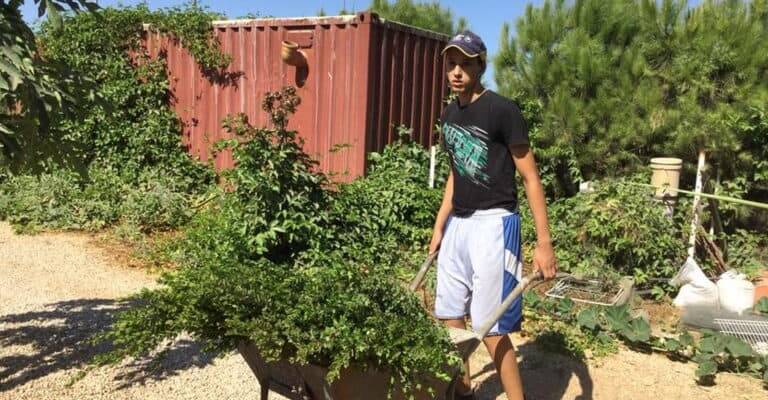While the four species make a seven-day appearance come fall, their growth is a year-long project that requires care and attention throughout.
By Naama Barak, ISRAEL21c
If you ever come across Jewish people waving around a bundle of leaves in the fall, fear not. They have not completely lost it, nor are they beating away an invisible swarm of bugs.
Instead, they are fulfilling a religious commandment meant to signify God’s mastery of the universe and serve as a reminder of the destructed Temple.
The said bundle is constructed from three types of leafy plants: lulav (palm branch), hadas (myrtle) and aravah (willow). Together with the etrog (citron), these make up the Sukkot holiday’s famous four species.
ISRAEL21c caught up with American-born Sue Muslow and her son Eitan, to hear the lowdown on how these plants are grown on the family farm, Meshek Muslow, in the small community of Beit Gamliel in central Israel.
“We have a small farm here, where we raise a variety of plants and we also raise the four species,” says Sue.
In addition to running the farm, which is open to visitors, Sue and her husband work full time in other jobs and got started on the four species due to their then-teen son’s interest.
“When I was about 15, we had three [willow] trees that we put in, and when my parents were building their house there was a lot of water, and these trees grew humongous,” Eitan explains.
“He started the business when he was 15,” Sue adds. “Then his two brothers started working with him. As a mother, it was such a good feeling to watch Eitan explain to his brothers what makes the aravot kosher [fit for use], what people want and where this is all learned.”
She says this reinforced the decision that she and her husband made to move to Israel in 1998 so that their children would be able to live a fully Jewish life “in a way you can only do here.”
Yearlong Attention
Growing the crops, the two note, involves a lot of work.
“You really have to take care of them all year around,” Sue explains. “You have to weed, and around Passover you need to cut the lulavim back, and the hadasim between Purim and Passover.”
“Also, for the hadasim, we cut off the water in Elul,” she says, referring to the Jewish month prior to the High Holidays.
“If you don’t, the end of the hadas will wilt if you don’t water it once you use it. If you let it grow stronger without any water, it becomes easier to use as part of the four species,” adds Eitan.
“Each of the four species needs its own care. The etrog, for example, is very time consuming and it’s very difficult to take care of,” says Sue. This is why the family doesn’t grow theirs for the market.
While the crops demand yearlong attention, the Muslows get really busy picking them right when the Jewish New Year begins, and work long days between Rosh Hashana and Sukkot.
“Lulavim start after Rosh Hashana,” Eitan explains. “Because if you wait too long, they open and then they’re not considered kosher anymore. Also, you can’t start too early, because then it just dies in the fridge – everything has to be close to Sukkot.”
“As for the aravot, everyone wants them fresh, so it only really starts after Yom Kippur,” he adds.
Patience and Clippers
When they first started selling the four species, the Muslows would sell willow branches right off the tree. Nowadays, they trim the branches and pack them up. Apparently, while it is a time-consuming business, prepping the leafy species requires little more than patience and clippers.
“To pick everything is pretty easy. Everything can be done with a pair of good scissors and that’s about it. The work is before – the spraying and the watering,” Eitan notes.
“The hadasim, meanwhile, don’t come out perfect, and you have to trim the middle and take out all the extras with small clippers.”
“The branch itself has several leaves on it,” adds Sue. “You need a triangle, or three from one branch, for it to be kosher. Not every single clump has three leaves together. There might be two or three that you need to clip to get a true hadas for the four species.”
Wonderful Willows
Meshek Muslow’s biggest seller is the aravot – the willow.
“Beit Gamliel, for some reason, has a lot of aravot growing here, some of the biggest in the country,” says Sue.
“Come Rosh Hashana, all the kids start picking the aravot from the different places. We hire kids to pick at night – because if you pick during the day they wilt – and then we package them up and sell.”
They try to sell as much as possible to resellers before Sukkot begins, but if they have a surplus they hire local kids to offer the willows for sale in areas where the four species are sold.
Look at the Big Picture
While etrogim are the most difficult species to nail in terms of their status and good looks, people can also apparently be quite picky about the other three species as well.
This leads Eitan to his top tip when it comes to choosing these items for Sukkot.
“I just heard this from someone very smart. He told me that he looks at the four species in the same way he wants to be looked at up in the heavenly court of judgment – not look at every small thing that he did, but the big picture.”
Do You Love Israel? Make a Donation - Show Your Support!
Donate to vital charities that help protect Israeli citizens and inspire millions around the world to support Israel too!
Now more than ever, Israel needs your help to fight and win the war -- including on the battlefield of public opinion.
Antisemitism, anti-Israel bias and boycotts are out of control. Israel's enemies are inciting terror and violence against innocent Israelis and Jews around the world. Help us fight back!



